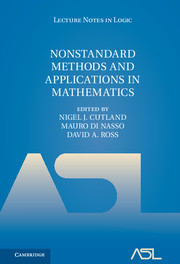The eightfold path to nonstandard analysis
from FOUNDATIONS
Published online by Cambridge University Press: 30 March 2017
Summary
Abstract. This paper consists of a quick introduction to the “hyper-methods” of nonstandard analysis, and of a review of eight different approaches to the subject, which have been recently elaborated by the authors.
Those who follow the noble Eightfold Path are freed from the suffering and are led ultimately to Enlightenment. (Gautama Buddha)Introduction. Since the originalworks [39, 40] by AbrahamRobinson,many different presentations to the methods of nonstandard analysis have been proposed over the last forty years. The task of combining in a satisfactory manner rigorous theoretical foundations with an easily accessible exposition soon revealed very difficult to be accomplished. The first pioneering work in this direction was W.A.J. Luxemburg's lecture notes [36]. Based on a direct use of the ultrapower construction, those notes were very popular in the “nonstandard” community in the sixties. Also Robinson himself gave a contribution to the sake of simplification, by reformulating his initial typetheoretic approach in a more familiar set-theoretic framework. Precisely, in his joint work with E. Zakon [42], he introduced the superstructure approach, by now the most used foundational framework.
To the authors’ knowledge, the first relevant contribution aimed to make the “hyper-methods” available even at a freshman level, is Keisler's book [33], which is a college textbook for a first course of elementary calculus. There, the principles of nonstandard analysis are presented axiomatically in a nice and elementary form (see the accompanying book [32] for the foundational aspects). Among the more recent works, there are the “gentle” introduction by W.C. Henson [26], R. Goldblatt's lectures on the hyperreals [25], and K.D. Stroyan's textbook [44].
Recently the authors investigated several different frameworks in algebra, topology, and set theory, that turn out to incorporate explicitly or implicitly the “hyper-methods”. These approaches show that nonstandard extensions naturally arise in several quite different contexts of mathematics. An interesting phenomenon is that some of those approaches lead in a straightforward manner to ultrafilter properties that are independent of the axioms of Zermelo-Fraenkel set theory ZFC.
Information
- Type
- Chapter
- Information
- Nonstandard Methods and Applications in Mathematics , pp. 3 - 44Publisher: Cambridge University PressPrint publication year: 2006
References
Accessibility standard: Unknown
Why this information is here
This section outlines the accessibility features of this content - including support for screen readers, full keyboard navigation and high-contrast display options. This may not be relevant for you.Accessibility Information
- 7
- Cited by
